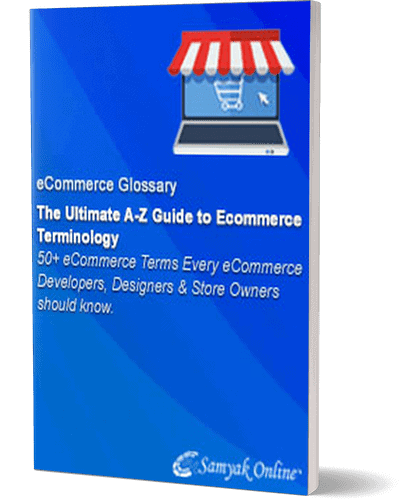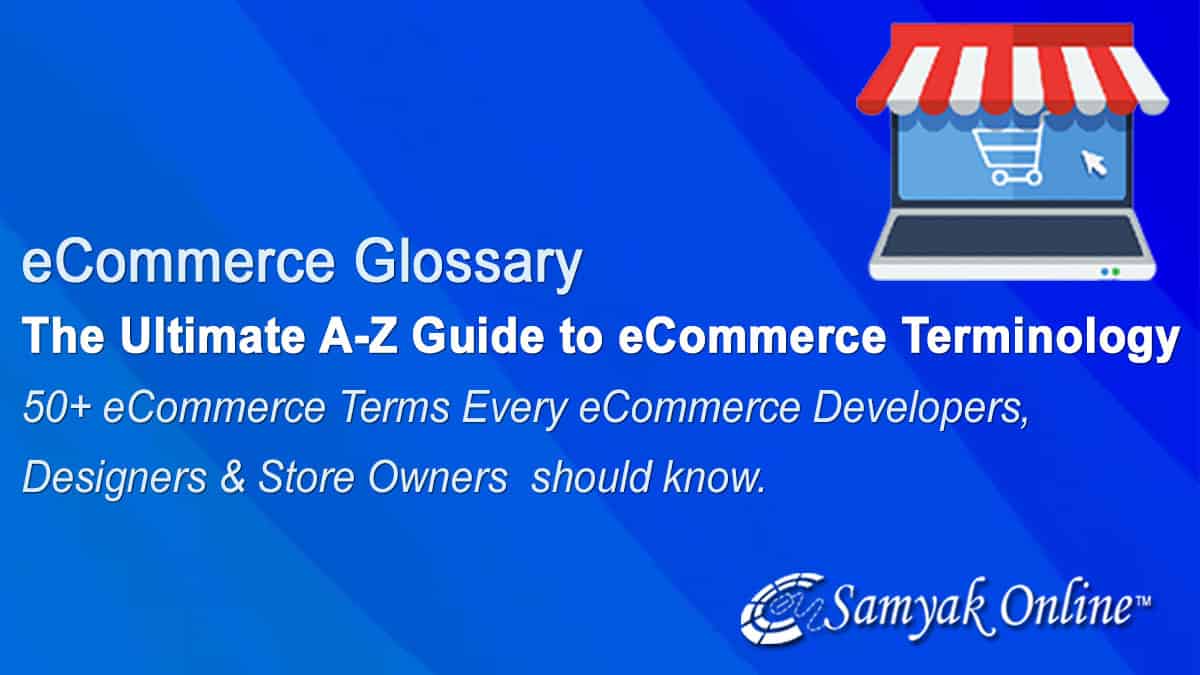eCommerce Glossary – The Ultimate A-Z Guide to eCommerce Terminology
50+ eCommerce Terms Every eCommerce Developer Designer & Store Owner should know
eCommerce developers and designers, especially newcomers and start-ups, often need help to grasp the various terms and buzzwords used in the ecommerce industry. Being unfamiliar with key ecommerce terminology puts them at a significant disadvantage and hampers their ability to communicate and negotiate with clients or stakeholders.
Given that many businesses seek ecommerce professionals’ expertise to enhance their online presence and drive sales, understanding the technical terms associated with ecommerce is crucial. Proficiency in ecommerce terminology empowers developers and designers to discuss project requirements, propose solutions, and establish better communication with clients.
The world of ecommerce has its own unique set of terminology and abbreviations. To help you navigate through this domain, here is an A-Z guide to ecommerce terminology:
Abandoned Cart Recovery
The process of reaching out to customers who have left their shopping carts before completing a purchase.
Address Verification Service (AVS)
A service that helps to verify the accuracy of a customer’s billing address by comparing it to the address information on their credit card.
Affiliate Marketing
A marketing strategy in which a business partners with other businesses to promote its products or services. The partner business, known as an affiliate, earns a commission for each sale it generates.
Application Programming Interface (API)
A set of rules that enables two software programmes to communicate. APIs are often used in ecommerce to allow businesses to integrate their online stores with other systems, such as payment processors or shipping carriers.
Average order value (AOV)
The average money a customer spends on a single order.
A/B testing
The A/B testing process allows you to analyse and evaluate different versions or options, enabling data-driven decision-making to optimise your marketing strategies and drive better outcomes for your business.
Imagine you have an online subscription service that provides two different subscription plans: Basic and Premium. To determine which plan generates more sign-ups, you conduct an A/B test on your pricing page. You randomly show the Basic plan to 50% of your website visitors and the Premium plan to the other 50%.
Over a specific period, you track the number of sign-ups for each plan. After analyzing the results, you discover that the Premium plan outperforms the Basic plan for generating sign-ups. With this insight, you can confidently implement the Premium plan as your primary offering, knowing it is more likely to attract higher conversion rates and revenue.
Black Friday
A day after Thanksgiving in the United States, known for its big sales.
B2B (Business to Business)
An ecommerce transaction in which businesses offer products or services to other businesses.
B2C (Business to Consumer)
An ecommerce transaction where firms directly offer consumer items or services.
Bounce rate
The percentage of people visiting a website who quit after only seeing one page.
Bundling
The practice of selling multiple products together as a single unit. Bundling can increase average order value or offer customers a discount on various products.
Brick and mortar store
A physical store that sells products or services. It’s window shopping where users need to visit there for shopping. Brick-and-mortar stores often offer a more personal shopping experience than online stores, as customers can interact with sales associates and ask questions about the products.
Call to Action (CTA)
A statement or phrase prompts and encourages a visitor to take a specific action, Like as clicking a button,“buy now,” “add to cart” or “contact us, signing up for a newsletter, or making a purchase.
Cart Abandonment Rate
The proportion of customers that add products to their carts but then abandon the checkout process.
It is calculated by dividing the number of completed transactions by the total number of orders begun, subtracting this outcome from one, and multiplying the whole thing by 100, i.e.,
(1 – (Completed Purchases / Total Orders)) x 100.
Chargeback
A request by a customer’s credit card company to reverse a charge made on their card. Chargebacks are due to numerous reasons, such as fraudulent purchases or customer disputes.
Checkout Process
A customer’s steps to complete a purchase on an online store. The checkout process typically includes the following:
- Entering billing and shipping information.
- Selecting a payment method.
- Reviewing the order before placing it.
Clickthrough Rate (CTR)
CTR stands for clickthrough rate. It measures how often people click on an ad when shown to them. The CTR is the ratio of proportion in which the number of clicks an advertisement receives to the number of times it is displayed. For instance, if an ad is shown 100 times and receives five clicks, then the CTR is 5%
Comparison Shopping Engine (CSE)
A website that allows users to compare prices from different retailers for the same product. Consumers often use CSEs to find the best deals on products.
Conversion
The intended action completed by a website visitor, which could be making a purchase, completing a form, or signing up for a newsletter.
Conversion Funnel
A conversion funnel describes the many stages of a customer’s online store journey. The ‘top of the funnel’ is when a buyer first learns about a product, and the ‘bottom of the funnel’ is when they actually purchase it. The conversion funnel is frequently divided into four basic stages: awareness, interest, desire, and action.
Conversion Rate
The proportion of people visiting the website who complete the specified action. A website’s conversion rate is an analysis of its efficiency and can be used to monitor the success of marketing initiatives.
Conversion Rate Optimization (CRO)
The process of improving a website’s conversion rate. CRO involves various techniques, such as A/B testing, optimising the website’s checkout process, and creating effective calls to action.
Cross-selling
Selling additional products or services to customers who have already purchased. For example, if a customer buys shoes, you might recommend a belt or a purse.
CSV file
It’s a plain text file in which data is separated by the commas. CSV files often export data from a website or online store.
In an ecommerce, We can import or export product data (SKU) into and out of online store building programmes in an ecommerce setting.
Customer Journey
A customer’s journey from when they first learn about a product or service until they make a purchase. Customer journeys can be used to identify areas where the customer experience can be improved.
Customer Lifetime Value (CLV)
The total money a customer is expected to spend with a business over their lifetime. CLV is a valuable metric for companies to track, as it can help them make decisions about allocating their marketing resources.
Discount code
A code that customers can use to get a discount on their purchases.
Dropshipping
A fulfilment method in which the seller does not keep the products in stock. Instead, when a customer orders, the seller purchases the outcome from a third-party supplier and has it shipped directly to the customer.
Ecommerce
The purchasing and selling of products and services over the internet or it can be physical. It is a subset of e-business, which refers to the general practice of running an online business.
Ecommerce Platform
A software application allowing businesses to create and manage online stores.
Faceted navigation
A way of organising products on a website by different attributes, such as size, colour, or price.
Flash sale
A short-term deal typically offered for a limited time only.
Fulfilment
The process of getting products from the seller to the customer.
Fulfilment by Amazon (FBA)
Offering by Amazon to the seller to store their products and goods in Amazon’s warehouses and transport them straight to customers.
Inventory
The stock of products that a business has available for sale.
Online marketplace
A website (for example amazon.com) that allows businesses to sell their products to a broader audience.
Payment gateway
A service that allows businesses to accept customer payments online.
PCI compliance
Businesses that accept payments online must follow specific security standards.
Point of sale (POS)
The system businesses use to process customer payments in person.
Product option
A product variation, such as a different size or colour.
Product variant
A combination of product options, such as a red shirt in size oversized.
Real-time carrier shipping
A system that enables companies to follow the progress of their shipments in real time.
Sales channel
How a business sells its products, such as through its website, an online marketplace, or a brick-and-mortar store.
Sales funnel
A visual representation of a customer’s steps to make a purchase.
Segmentation
Distinguishing users into groups based on shared criteria such as interests or demographics.
Shopping cart
The virtual container that customers use to store the products they want to purchase.
SKU (Stock Keeping Unit)
A unique identifier assigned to each product in a business’s inventory.
Transaction fee
A fee that a payment gateway or other service provider charges when a customer makes a payment online.
Universal Product Code (UPC)
A barcode used to identify products in retail stores.
Upselling
Selling customers more expensive or higher-margin products than they originally intended to purchase.
Wishlist
A wishlist is a feature on e-commerce websites that lets customers save products they’re interested in for future purchases. Customers can return to the saved products later, share their wishlists with others for gift ideas or collaboration, and track price changes to get the best deals. Wishlists are virtual shopping lists that allow users to save things they want to buy later, share them with others, and keep an eye on price changes.
About Author:
Subhash Jain is the founder of Samyak Online, a leading e-commerce development and design agency. Having years of experience in the industry, Subhash has helped businesses of all sizes create and launch successful e-commerce websites. Contact us today to learn more about how I can help you create a successful e-commerce website.



Leave a Reply
Want to join the discussion?Feel free to contribute!